The Battle of Imphal was fought simultaneously with the Battle of Kohima & consisted of several concurrent independent battles fought across the flat Imphal Plain & the jungle-covered hills that surround it.
Imphal is the capital of Manipur State, the most eastern province of India. It lies adjacent to Burma, a British colony that fell to the Japanese in 1942.
In March 1944, Indian 4 Corps was based at Imphal. Its 17 & 20 Divisions were isolated near the frontier in vulnerable positions, intended as bait. If attacked, they would fall back to strong defences at Imphal, luring the Japanese away from their sources of supply. The concentration of Allied forces at Imphal was likened by Lieutenant General Bill Slim to a tethered goat, that would lure the Japanese to their destruction.

Lieutenant General Mutaguchi did what the Allies hoped, sending one division against each of the exposed Indian divisions. But he wrong-footed the Allies by sending his third division (31) to Kohima, cutting the road that kept Imphal supplied. This caused a crisis.
Dispersed amongst the three Japanese divisions was the Indian National Army, which aimed to provoke the population of India to rebel against colonial rule by the British. They were unsuccessful.
17 Division was located around Tiddim, 150 miles south of Imphal. Slow to respond to the invasion, it was nearly outflanked & cut off, but 4 Corps reserve (23 Division) arrived just in time to keep open the road back to Imphal.
Sending 4 Corps reserve south left Imphal vulnerable to attack from the north. 50 Indian Parachute Brigade provided temporary cover, with an heroic stand at Sangshak that delayed the Japanese advance.
The crisis was averted by flying Indian 5 Division into Imphal, the largest airlift in history. Air superiority & a huge transport fleet was decisive for the Allied victory. By the end of the battle, 12,000 men had been flown in & 13,000 casualties flown out. The air force also kept Imphal supplied after its road link was cut, delivering 19,000 tons of food, fuel & munitions.

Attacking from the north, the Japanese seized Nungshigum Ridge that overlooked Imphal Main airport, threatening the air lifeline of 4 Corps. Supported by 5 Division, Lee tanks climbed the steep slopes onto the Ridge to drive off the Japanese, with heavy losses on both sides, especially among officers. South-east of Imphal, Indian troops repulsed an attack by the Indian National Army on the airport at Palel.
Indian 20 Division defended the main road from Tamu into Imphal. This was vital, as it was the only road that the Japanese could use to bring tanks & heavy artillery close enough to attack Imphal. Both sides suffered severe losses as positions changed hands.
Japanese attacks ground to a halt by May, due to crippling casualties & inadequate supply. Mutaguchi replaced his divisional commanders, who no longer believed they could capture Imphal. The change of leadership led to fresh attacks, but desperate fighting failed to shift the Indians & drained the remaining strength of the Japanese.

5 Division pushed north & on June 22 met up with British 2 Division advancing south from Kohima. Supplies could now reach Imphal by road & the siege was over. Mutaguchi demanded more attacks, but his forces were no longer capable, so he ended the offensive on July 3. The invasion of India had failed.

Casualties for the Battle of Imphal were estimated as approximately 12,600 for the Allies & 54,900 for the Japanese.





